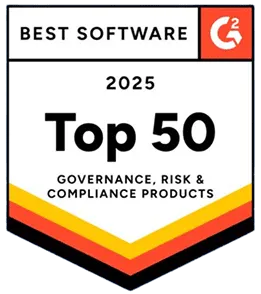
If compliance is just about checklists for you, you’re missing the bigger picture. It’s about security, efficiency, and trust—and Scrut helps us achieve all three. Scrut has become a crucial part of our security stack.
Ditch out-of-the-box compliance. Switch to automated, risk-first compliance that fits your business’ specific needs with Scrut.

%201.avif)




































.jpg)
Don’t stay limited to surface-level protection that stops at endpoints and IP addresses. Get insights across all cloud infrastructure, applications, people, and third party risks.
Map controls across all your security initiatives, tie risks to mitigating controls, and cut out redundancy by reusing controls as you scale.

Automate control monitoring, evidence collection, and set up recurring workflows for routine tasks. Connect Scrut to your favourite task management tools and get instant alerts on risk mitigation tasks that need your attention.
.jpg)
Track your compliance status against every framework under the sun (or build a custom one—it’s your show). When it’s audit time, breeze through both internal and external reviews with confidence. No panic, no surprises.



Let Scrut evaluate the effectiveness of your controls 24/7, non-stop. Get notified of gaps and share step-by-step remediation guidelines, right in your task management tools.
Collect evidence on the way, and so that you never have to hunt down documents for audits

Configure workflows, create custom frameworks and controls, trigger custom tests, and build custom risk formulas for tailored risk assessment.
Build a security program that’s as unique as your business, directly from the interface.

Start with complete coverage: compliance frameworks, policy templates, risk registers, and vendor questionnaires—all pre-mapped to unified controls, so you don’t waste time starting from scratch or duplicating work.

From a Setup Wizard that tracks your progress, to Scrut Teammates that decode control choices in real time, to hands-on support from our InfoSec team—you're never on your own.
Whether it’s onboarding, audit prep, or tightening your risk posture, we get you there faster—and smarter.

Let Scrut evaluate the effectiveness of your controls 24/7, non-stop. Get notified of gaps and see step-by-step remediation guidelines, right in your task management tools.
Collect evidence on the way, and so that you never have to hunt down documents for audits

Configure workflows, create custom frameworks and controls, trigger custom tests, and build custom risk formulas for tailored risk assessment.
Build a security program that’s as unique as your business, directly from the interface.

Start with complete coverage: compliance frameworks, policy templates, risk registers, and vendor questionnaires—all pre-mapped to unified controls, so you don’t waste time starting from scratch or duplicating work.

From a Setup Wizard that tracks your progress, to Scrut Teammates that decode control choices in real time, to hands-on support from our InfoSec team—you're never on your own.
Whether it’s onboarding, audit prep, or tightening your risk posture, we get you there faster—and smarter.




If compliance is just about checklists for you, you’re missing the bigger picture. It’s about security, efficiency, and trust—and Scrut helps us achieve all three. Scrut has become a crucial part of our security stack.



Scrut saved us time and resources—so we could stay focused on growing the business.



Scrut stood out as the most comprehensive platform we saw—and it saved us time that directly translated into cost savings.



The platform connects with a wide range of tools for continuous monitoring, which makes compliance easy to manage.
.webp)


Scrut helps us look inward too—we can review past audit trails, spot gaps in controls, and prep smarter for the next audit.
.webp)


We wouldn’t have been able to get ISO 27001 compliant, without Scrut’s help and expertise.



Scrut helped us automate the audits and compliances along with vendor risk assessments.



Scrut was key during our ISO 27001:2022 transition—the platform and their support made everything faster and smoother for our team.



I needed a solution where every team—Engineering, Legal, HR—could handle compliance without slowing down productivity. With predefined workflows and centralized visibility, that’s now a reality.



Handling sensitive equity data means security and privacy are top priorities. Scrut Automation helped us to comply with the gold standard of privacy, GDPR, by providing real-time visibility into our security posture, enabling us to adequately protect the sensitive data that we hold for our customers.



“Just the fact that Scrut has included a platform to execute awareness campaigns in the product itself is actually a big selling point. The collection of information from HR integrations and execution of the campaigns through the platform works quite nice."



Precise, concise, and a very organized platform to gather all your audit requirements The uptime is amazing and we were able to integrate it into our internal productivity tool. How cool is that?!



Due to Scrut’s structured approach to compliance, navigating complex regulations has become a manageable part of our daily operations.



Scrut’s platform made fintech compliance easy to navigate—and helped us raise the bar on security at Cashfree.



What stands out is the bird's-eye view of dashboards in terms of policy statuses, evidence, and critical issues. I don’t have to go look around; it's all there in front of me. That’s what really matters.



Scrut’s risk management stood out—clear, complete, and built to handle it all: identify, assess, and mitigate.
.webp)


Scrut Automation enhances risk and vendor management. Scrut Automation tool helps to identify, assess, and prioritize risks and develop strategies to mitigate them.



Scrut helped our company navigate the complexities of SOC 2, ISO 27001, HIPAA, GDPR, CCPA, and PCI compliance with ease.”
.webp)


Scrut helps us stay compliant with SOC 2—without draining our time. As a small team, we can prove we’re protecting data and still stay focused on our customers.



Balancing SOC 2 audits with fast product cycles was tough—Scrut made both possible. We passed the audit without missing a beat in product development.



With Scrut’s automated cloud monitoring, we gained complete visibility into our compliance process and successfully achieved ISO 27001, GDPR, SOC 2, and HIPAA certifications.



As we scaled and chased new certifications, Scrut delivered value from day one—smooth platform, smooth progress.



We’ve got way more control over our GRC operations now. Scrut’s innovative platform has helped us prioritize strategic security programs. The lift in our risk management efforts has been majorly reduced, thanks to its adaptability with our tech stack and workflows.


Scrut Agent has been quite helpful in ISMS implementation and we saved our budget on the MDM solution.



Since using the Trust Vault, I’ve had to fill out far fewer vendor security questionnaires—huge time-saver.



I liked Scrut's watchdog agent feature, which checks all employee systems and notifies in case of any misses.



Scrut made our audits smoother and multi-framework compliance more efficient.



Scrut helps us keep a live track of all our compliance and control records with seamless tracking, assigning, and completing tasks.



Scrut helped us get SOC2, ISO27001, GDPR and CCPA faster and efficiently. Their pricing was also better than all of the other vendors we looked at in the space.



Scrut automates evidence collection, tracks compliance, and trains our team—all in one clear, easy-to-use platform.



Scrut’s templates helped us prep for SOC 2 audits with clarity and speed.



What stands out is the bird's-eye view of dashboards in terms of policy statuses, evidence, and critical issues. I don’t have to go look around; it's all there in front of me. That’s what really matters..



“ Both the monitoring platform and provided content seamlessly integrated with our service providers and were easy to customize as needed. Compliance with SOC 2 and ISO 27001—delivered without hassle, guesswork, or drama.”



Working with Scrut to get ISO 27001 and SOC 2 compliant was such a relief. Their platform helped us spot gaps in our security posture, and strengthen our security operations.



With Scrut, we’ve been able to show the right policies, procedures, and evidence—opening doors to more deals.



“ We were looking for multiple compliance certifications such as SOC2, NIST, HIPAA, FERPA, ISO 27017, ISO 27001,CSA Star, ISO 22301, ISO 27018, ISO 20000-1, GDPR. Scrut automation has made our compliance journey very easy and also provide a single dashboard with all the data in one place. ”



Thanks to Scrut, we’re saving nearly 100 hours every month across our GRC and solutions teams.



“ Commitment to security is one of the fundamental building blocks, and compliance is our way of showcasing our commitment to the world. With Scrut, managing our information security posture was a breeze. “



“The beauty of Scrut is the convenience of automation combined with the unmatched human expert support.“



“Scrut has an easy UI and provides better navigation. Their team helped us organize training and support throughout our compliance journey. “



“Thanks to Scrut Automation, we were able to manage compliance with SOC 2, ISO 27001, and GDPR seamlessly, which otherwise would have been strenuous for our teams. The platform helps us keep a close eye on our infosec posture and take the necessary steps to strengthen it."



“Scrut gave us added confidence in managing documentation for ensuring continuous compliance across 3 standards, and now we’re in the process of getting our HIPAA certification as well!"



“Aptitude and reliability go hand in hand. While there are a lot of namesake tools in the market, Scrut's efficiency is driven by a combination of the platform and their solid infosec expertise.”
.webp)


“Finding a balance between the time-consuming SOC 2 Audit and our fast-paced product development was challenging, but Scrut made this a reality. We were able to complete the audit while maintaining the pace of product development, helping us accomplish two of our goals at the same time.”



We used to rely on manual inputs to track risks, which meant things often slipped through. Scrut Teammates now surfaces risks from all corners—cloud, vendors, applications and more—and keeps our risk register continuously updated. The suggested treatments and mitigation steps make it easy for the team to respond quickly.



Scrut’s flexible platform and people-first support have been key to our compliance success.



We’re not just ticking boxes. Compliance is a business enabler for us, and Scrut helps us stay ahead of the curve



With Scrut, it’s simple—just head to secure.vablet.com and everything you need is right there. Doesn’t get easier than that.



Scrut scans our entire infrastructure with a fine-tooth comb and shows us exactly what to fix.



From day one, the Scrut team made our ISO, SOC 2, and GDPR journey seamless. They understood the complexities of our open-source setup and kept us on track with smart, timely support.
.webp)


Scrut had everything in place from day one. It showed us exactly what we were missing—and made the entire journey smoother than anything we’d done before.”



What stood out with Scrut was how structured the process was—we got a clear roadmap to SOC 2 Type 2 from day one.



We didn’t have a dedicated compliance team, so using Scrut — especially alongside Slack — made it much easier to manage everything. Even with limited resources, we were able to achieve PCI DSS compliance.



Scrut helped us show that all the security work we’ve been doing behind the scenes is worthwhile — because you can demonstrate it to customers. That’s helped win deals.


Connect the Scrut Platform to your tools. Automate control monitoring and evidence collection from the word ‘go.’






The Scrut Platform helps you move fast, stay compliant, and build securely from the start.
Scrut helps you set up a security program that scales with your business and stands up to audits. Without last-minute chaos.
Scrut helps you streamline audits, close deals faster, and stay ahead of risk without slowing down your team. Because trust shouldn’t take months to earn.
Scrut helps you set up a security program that scales with your business and stands up to audits. Without last-minute chaos.
Tag, classify, and monitor assets in real time—without the manual overhead.
Whether you're entering new markets or launching new products, Scrut helps you stay compliant without slowing down.
Scrut pulls compliance data straight from the tools you already use—so you don’t have to dig for evidence, chase approvals, or manually track controls.
Less manual work, more customizability. The Scrut Platform gives you everything you need to align your compliance to your business’s priorities.
With Scrut, you’re not just adding a tool to your offering—you’re adding a competitive edge. Join our Partner Network and help your clients streamline their GRC program.
Gaining trust is your first step to growing and cracking better deals. The Scrut Platform comes pre-built with all the tools you need to showcase a firm security posture and build confidence.
Don’t settle for rigid systems—Scrut ensures your risk management strategy is as flexible as your business needs.
Start building a security-first culture. Save your operations from improper training and a lack of compliance awareness.
Scrut fast-tracks compliance so you can focus on scaling, not scrambling. Automate compliance tasks and accelerate enterprise deals—without the grind.
Automate assessments, track compliance, and get full visibility into third-party risk—all in one place.
Scrut automates compliance tasks, supports proactive risk management, and saves you time, so you can focus on growing your business. Start building trust with customers and scaling confidently.
Leave legacy GRC behind. Meet the AI-powered platform built for teams managing risk and compliance in real time.
Give auditors direct access, keep track of every request, and manage audits effortlessly—all in one place.
Scrut ensures access permissions are correct, up-to-date, and fully compliant.
Whether you need fast results or a fully tailored program mapped to your risks and needs, Scrut delivers exactly what you need, when you need it. Ready to start?
Scrut unifies compliance across all your frameworks, so you can stop juggling systems and start scaling securely.
Manually managing your compliance processes and audits can get inefficient and overwhelming. Scrut automates these outdated, manual processes and eliminates your last-minute worries.
Access automated compliance, real-time risk tracking, and expert-backed support—all in one platform. Get started with Scrut!
Less manual work, more customizability. The Scrut Platform gives you everything you need to align your compliance to your business’s priorities.
The Scrut Platform helps you move fast, stay compliant, and build securely from the start.
Earn trust and back it up with solid evidence. Scrut takes you through the SOC 2 compliance journey step-by-step, navigating every complexity you face.
Manage your PCI DSS compliance with real-time monitoring and effortless automation. Get started with Scrut today!
Securing your PHI shouldn’t be a constant hassle. Scrut automates your workflows—from risk assessments to monitoring—so you can put your compliance worries on the back burner.
Automate security controls, simplify audits, and keep your ISMS aligned with the latest standards. Get started with Scrut!
Tackle potential AI risks with NIST AI RMF-compliant controls and get expert support every step of the way.
Offload the grunt compliance work to us. Execute manual, draining GRC tasks with the reliable AI-powered Scrut Teammates without switching contexts or bottlenecks.
Whether you're managing student data, partnering with educational institute, or expanding to new geographies—Scrut gives you the tools to stay compliant, manage risk, and build trust at every step.
Scaling healthcare doesn’t have to come at the cost of security. Scrut keeps your organization compliant, audit-ready, and protected—no matter how fast you grow.
Scrut automates the hard parts of compliance and security so you can move fast and stay ahead of risks from day one.
The Scrut Platform helps you move fast, stay compliant, and build securely from the start.
Growth in fintech comes with heavy scrutiny. Scrut helps you stay compliant, audit-ready, and secure—without slowing down your momentum.



